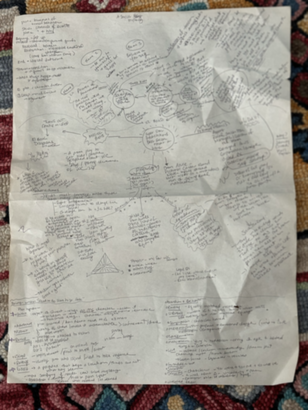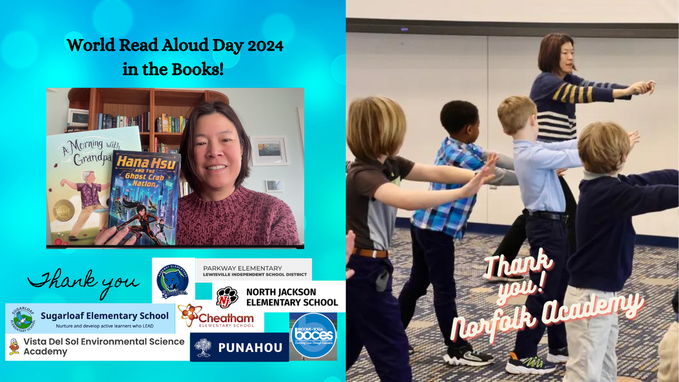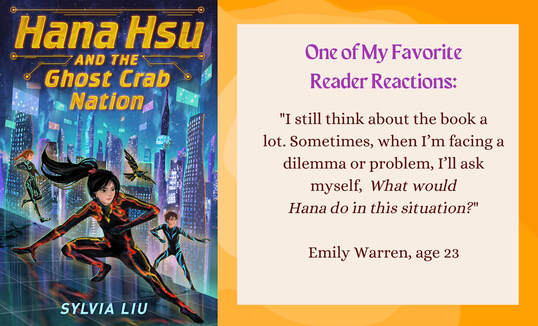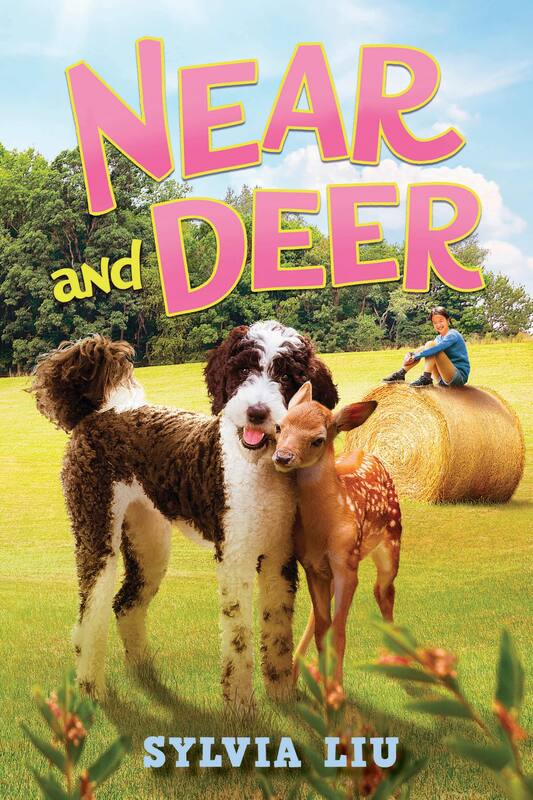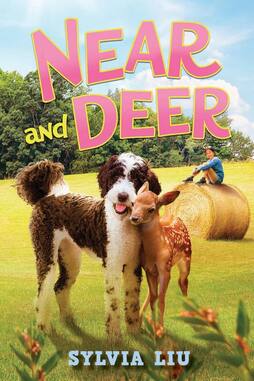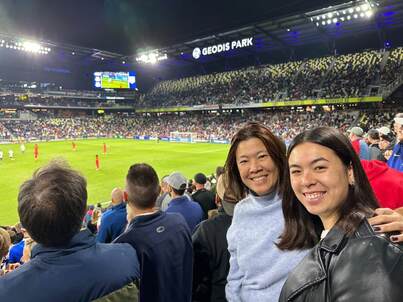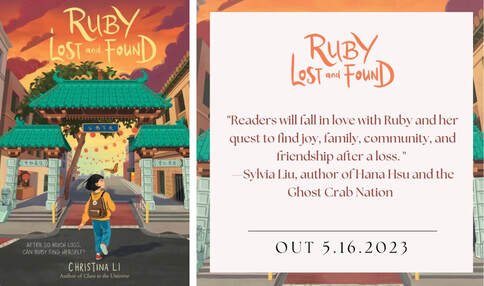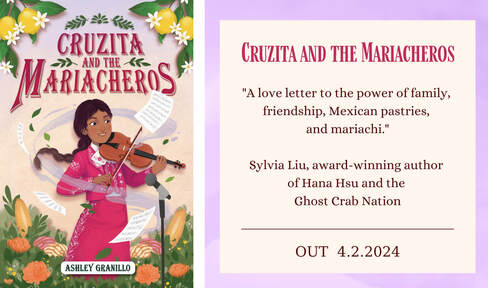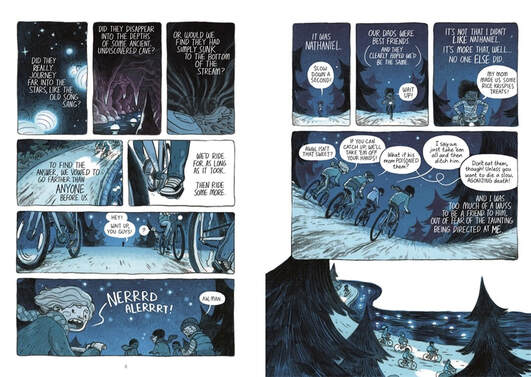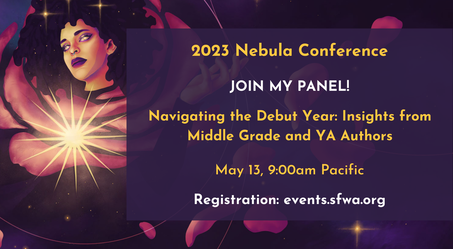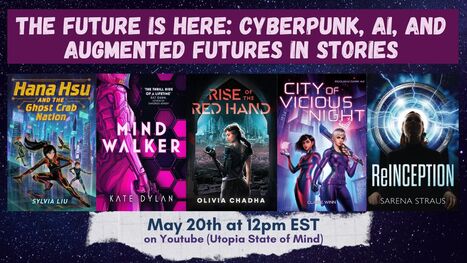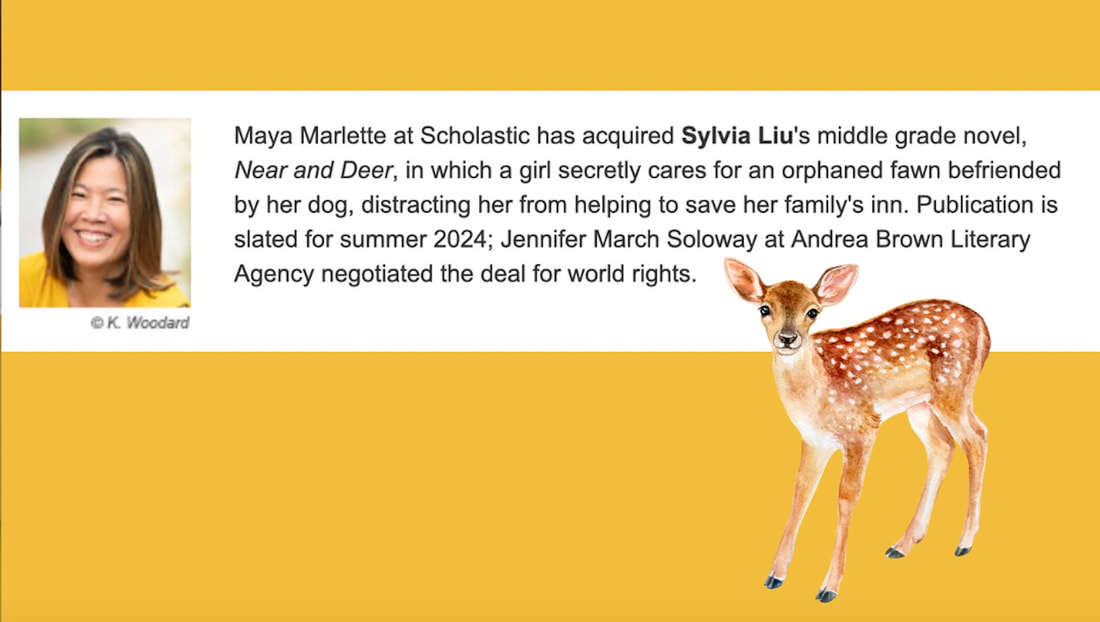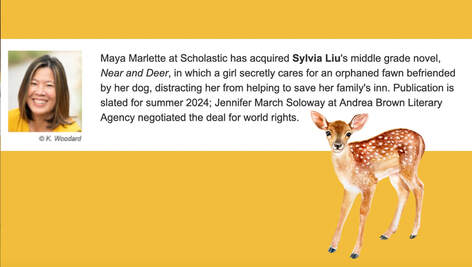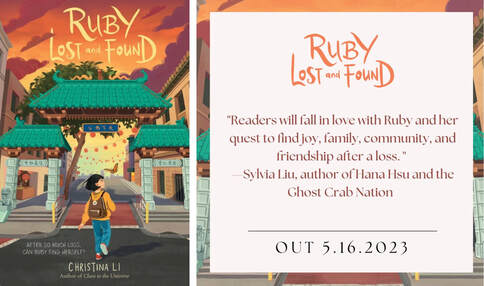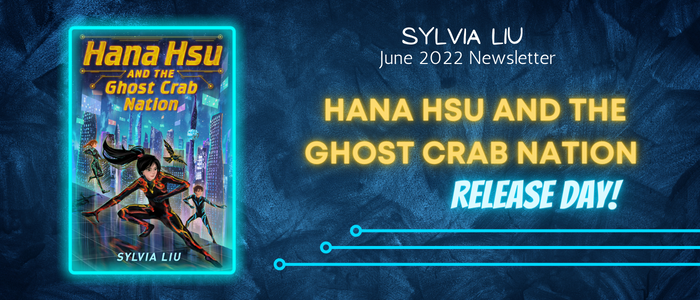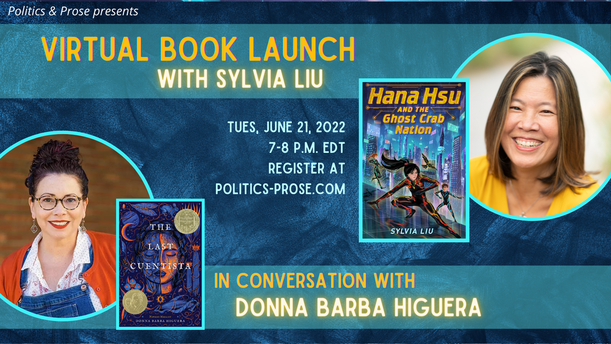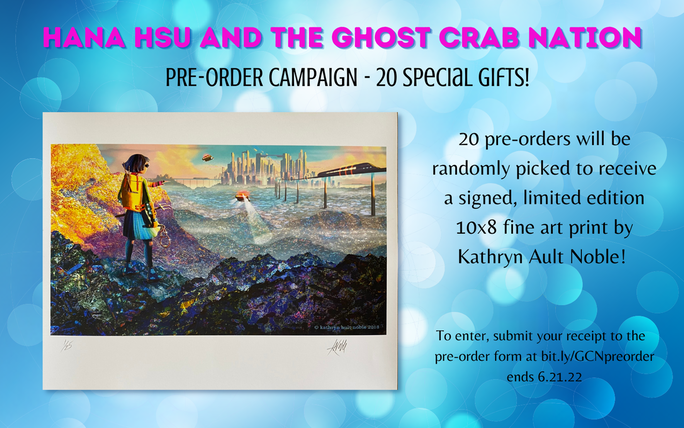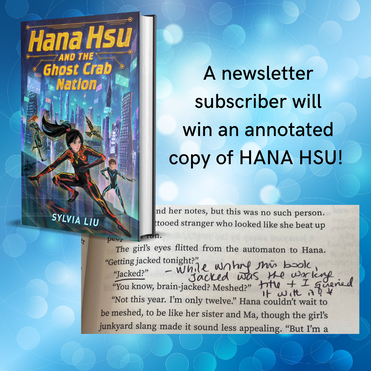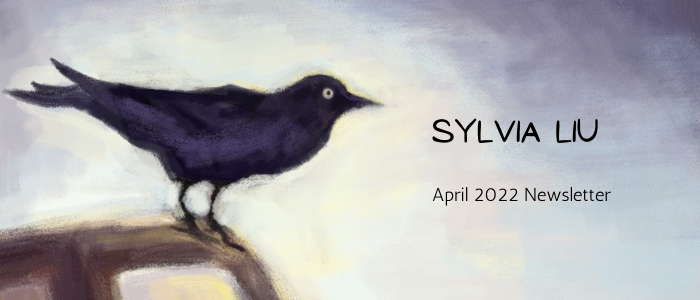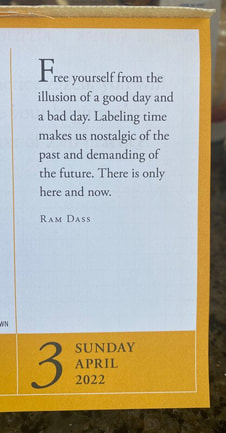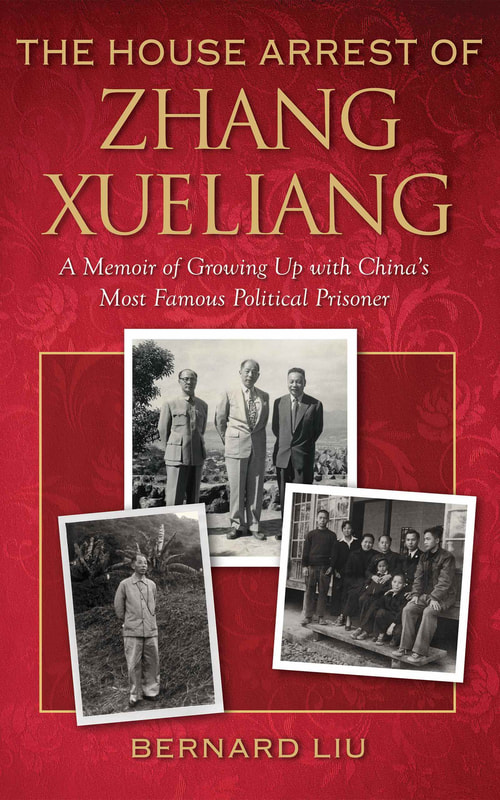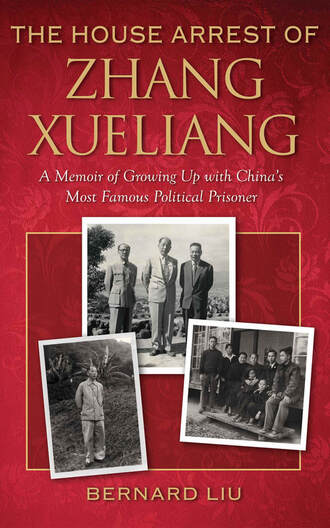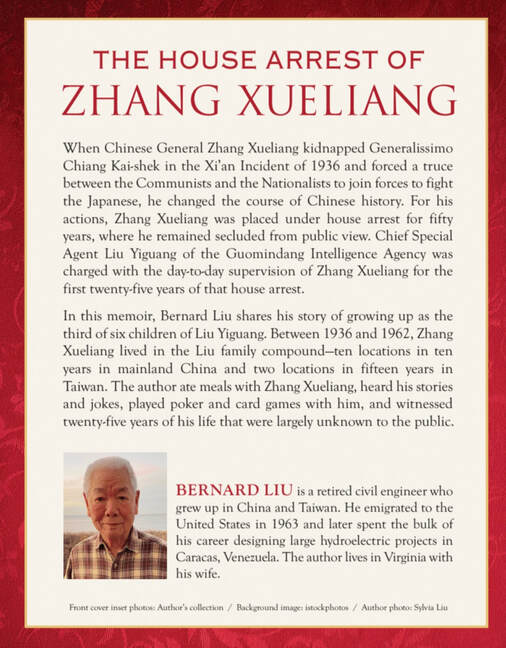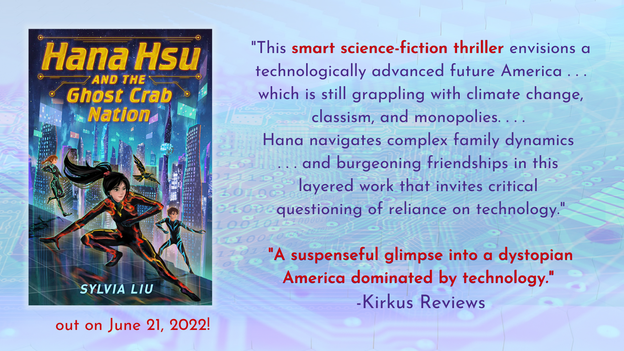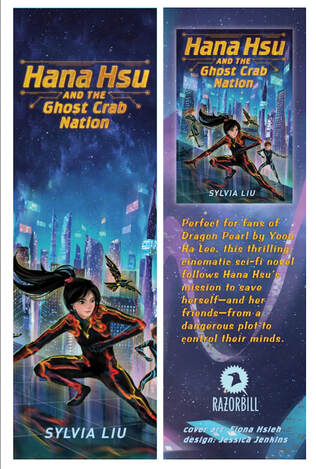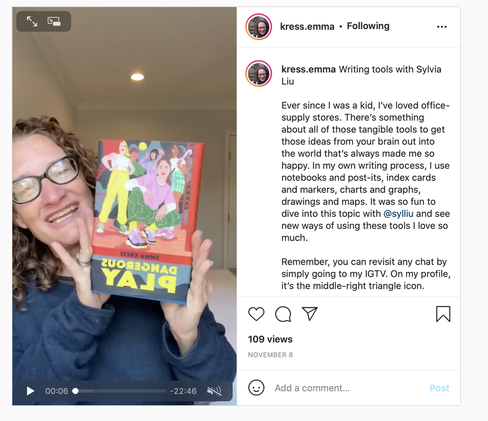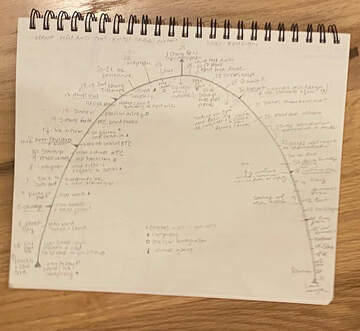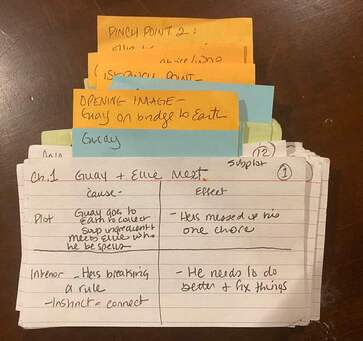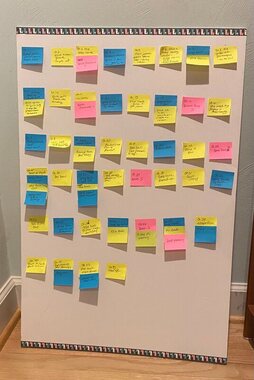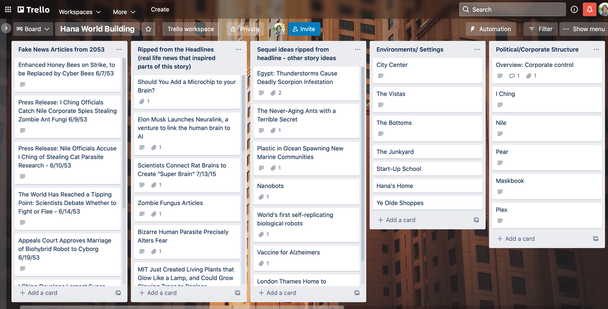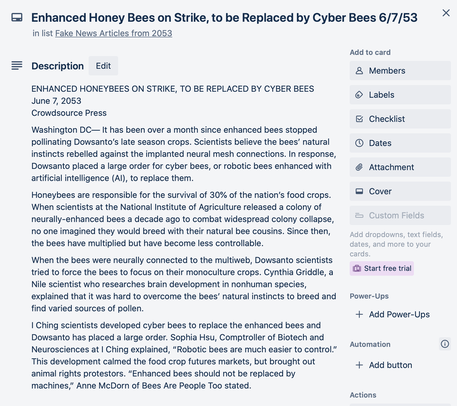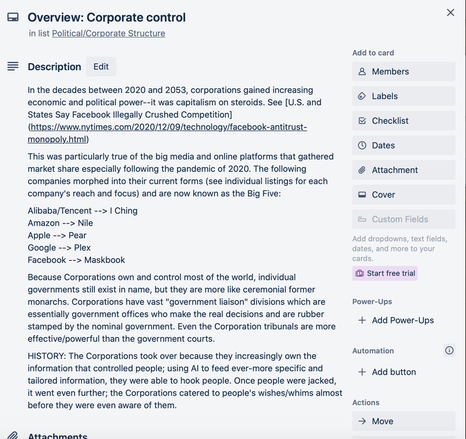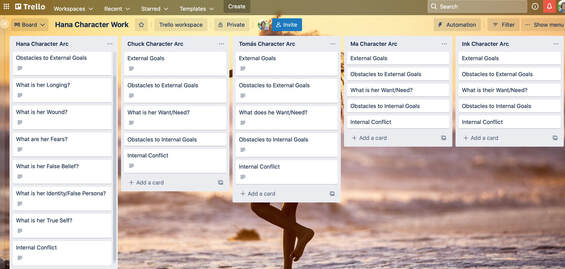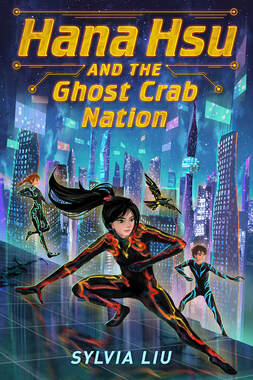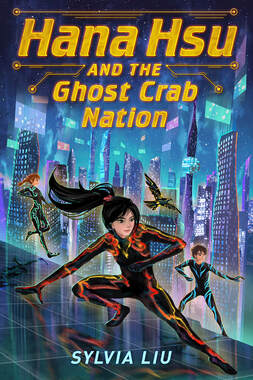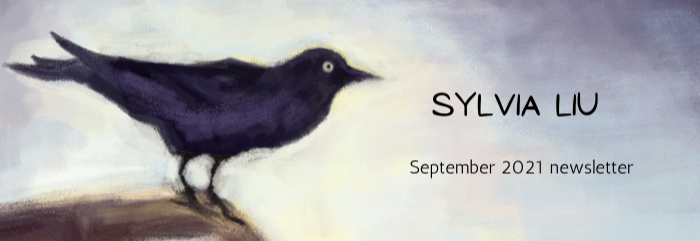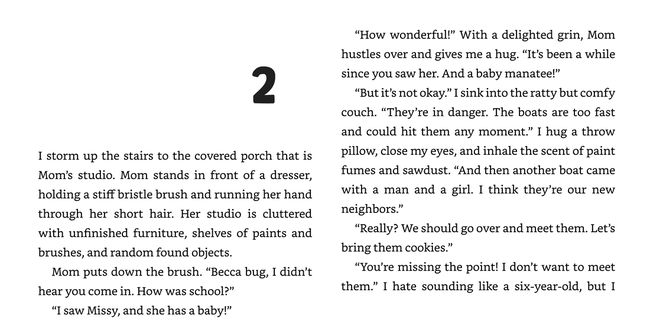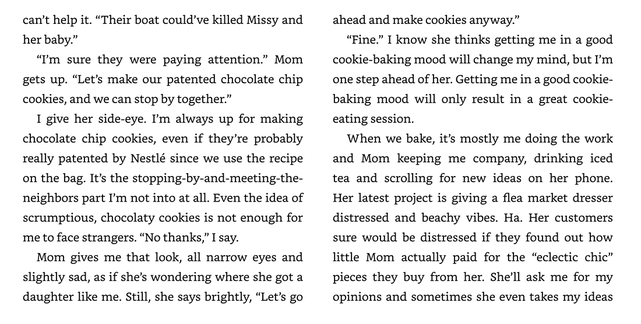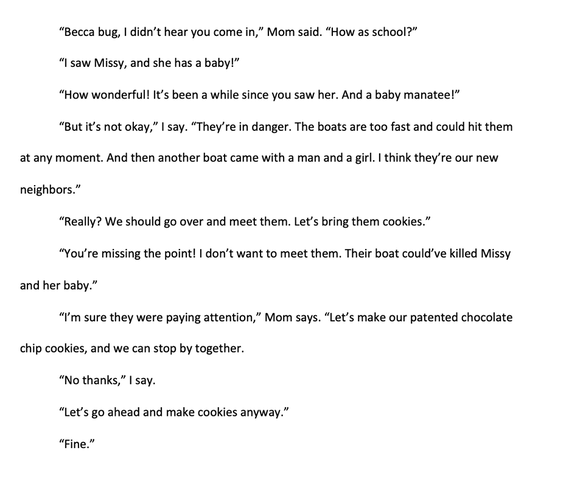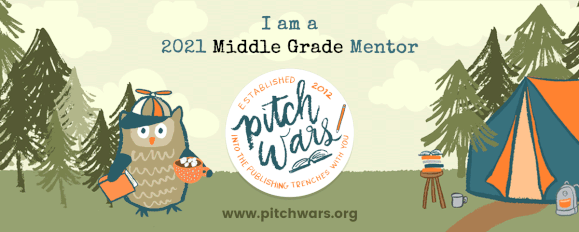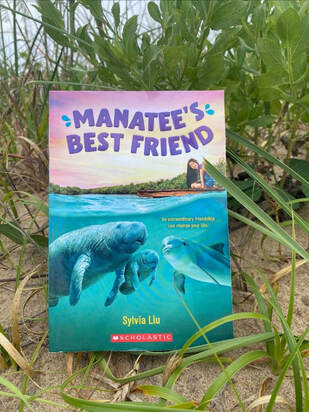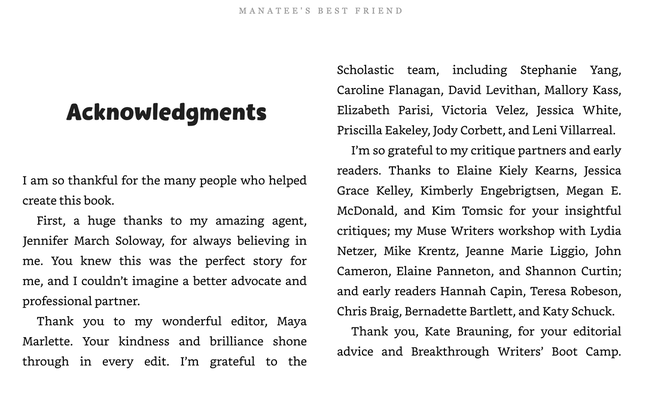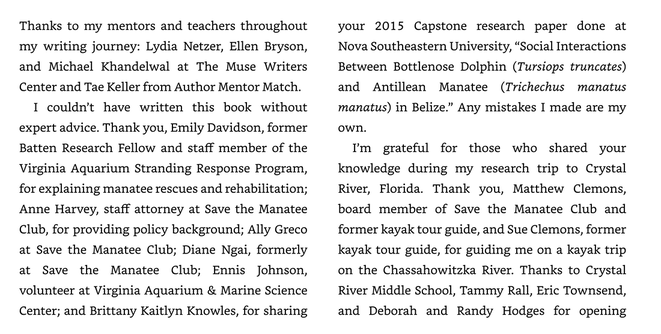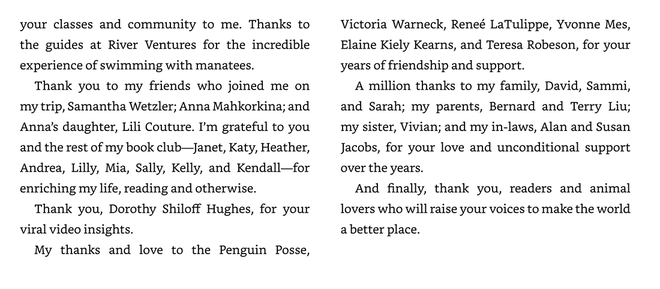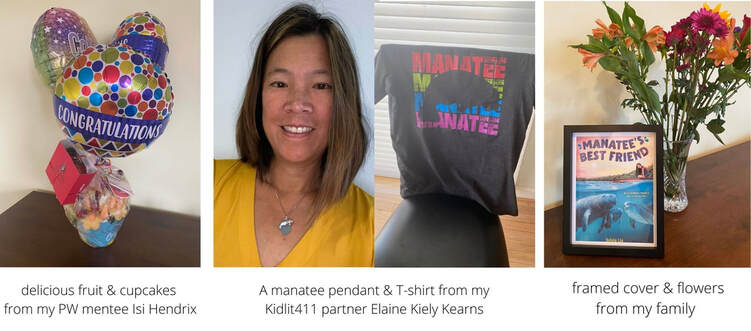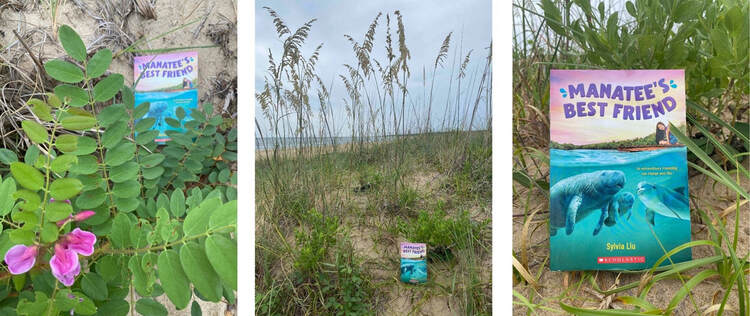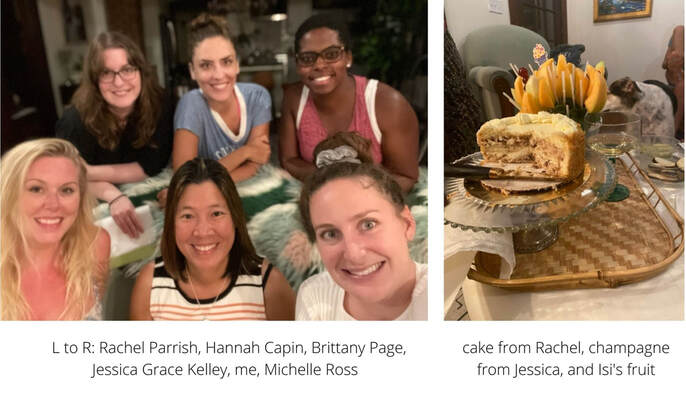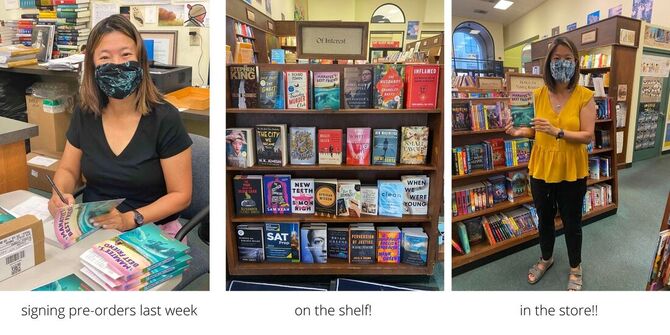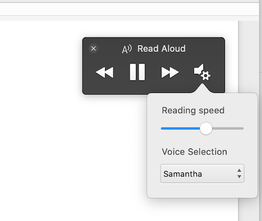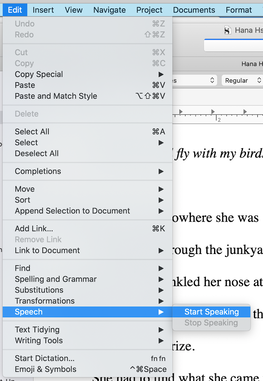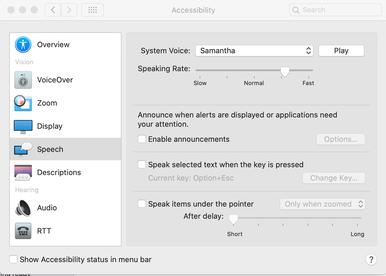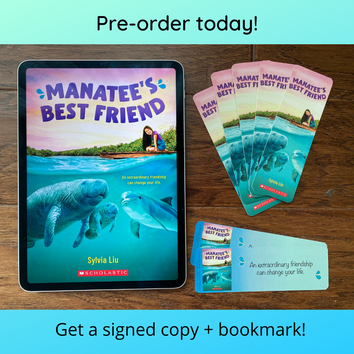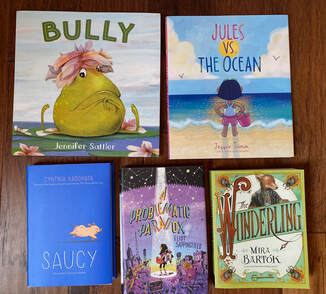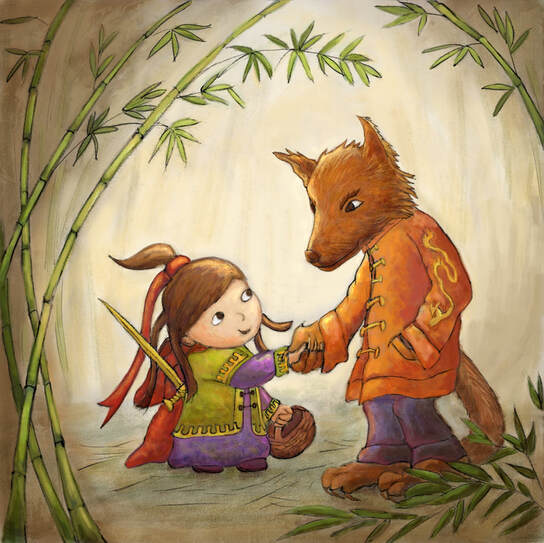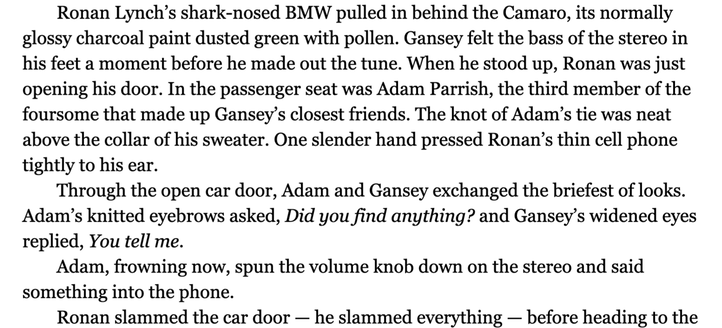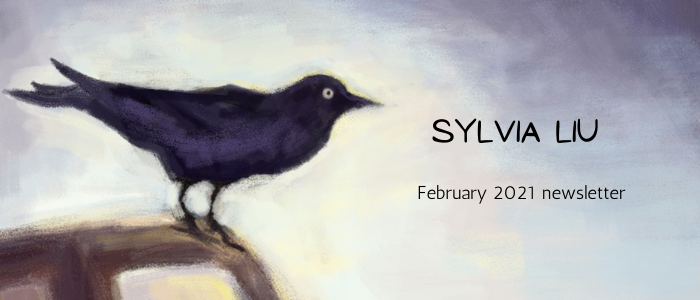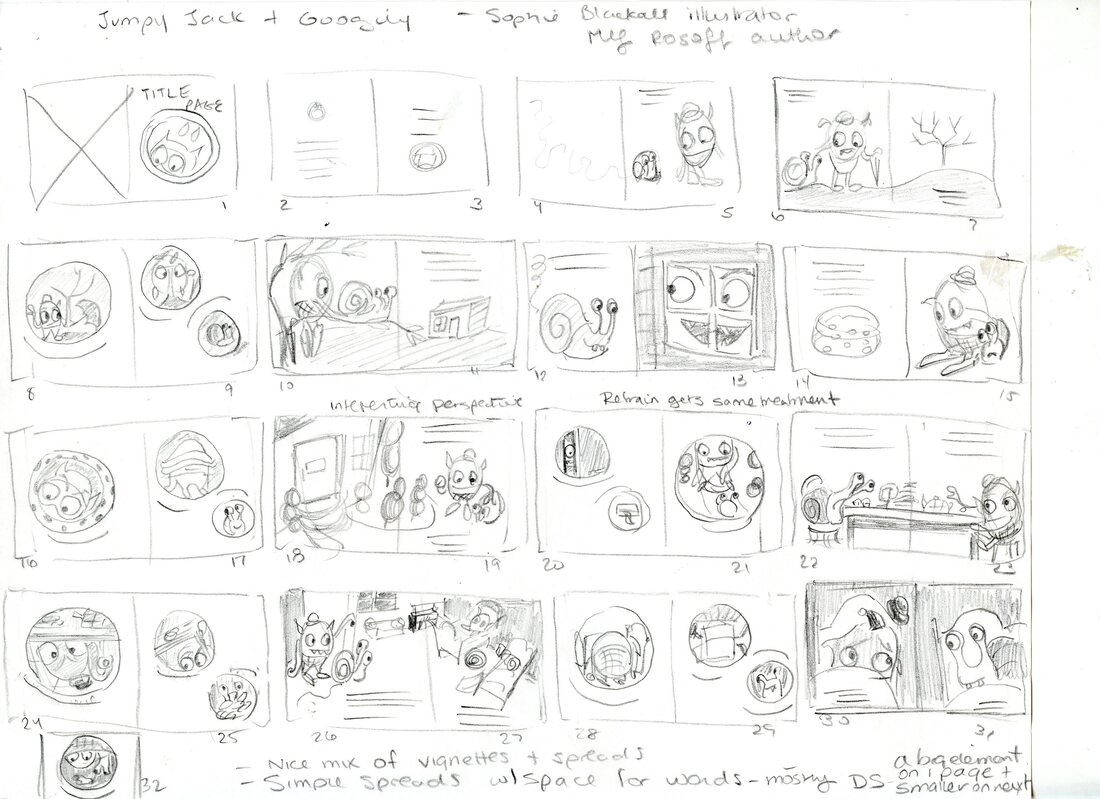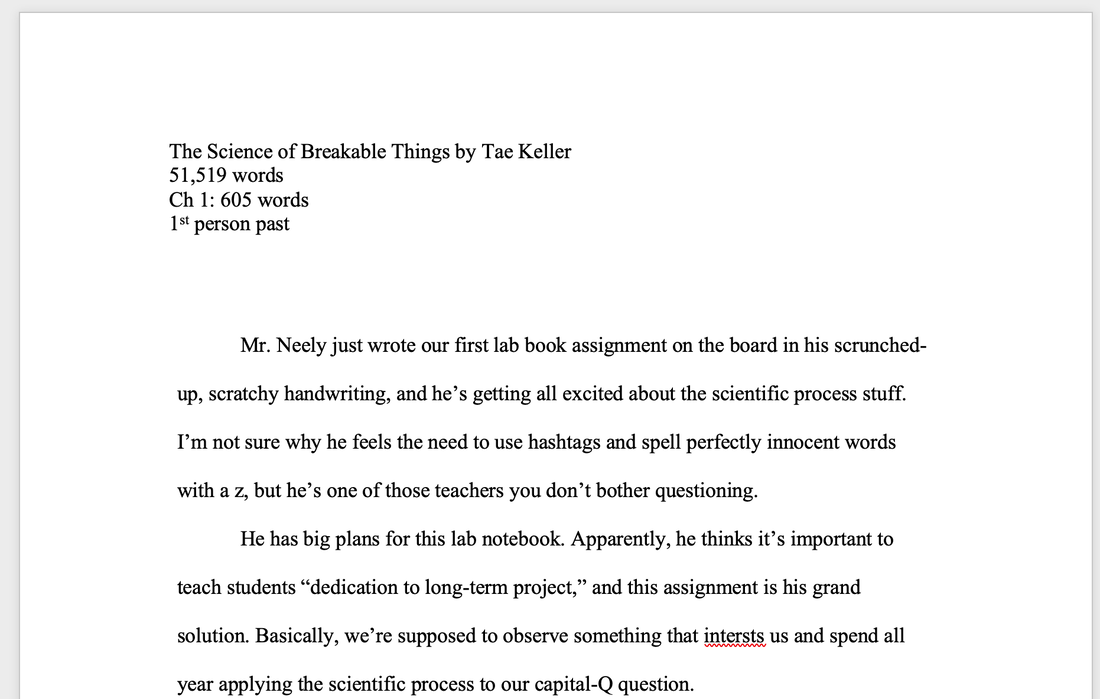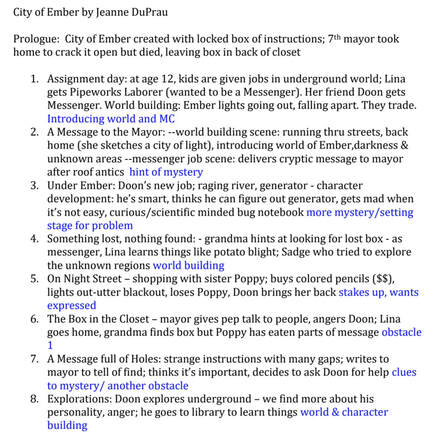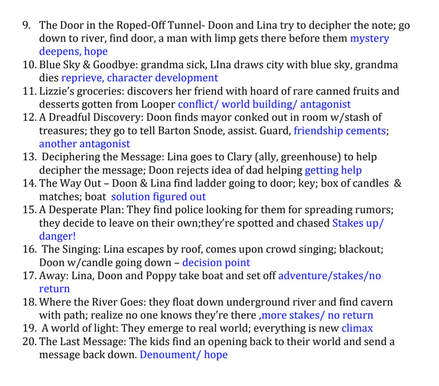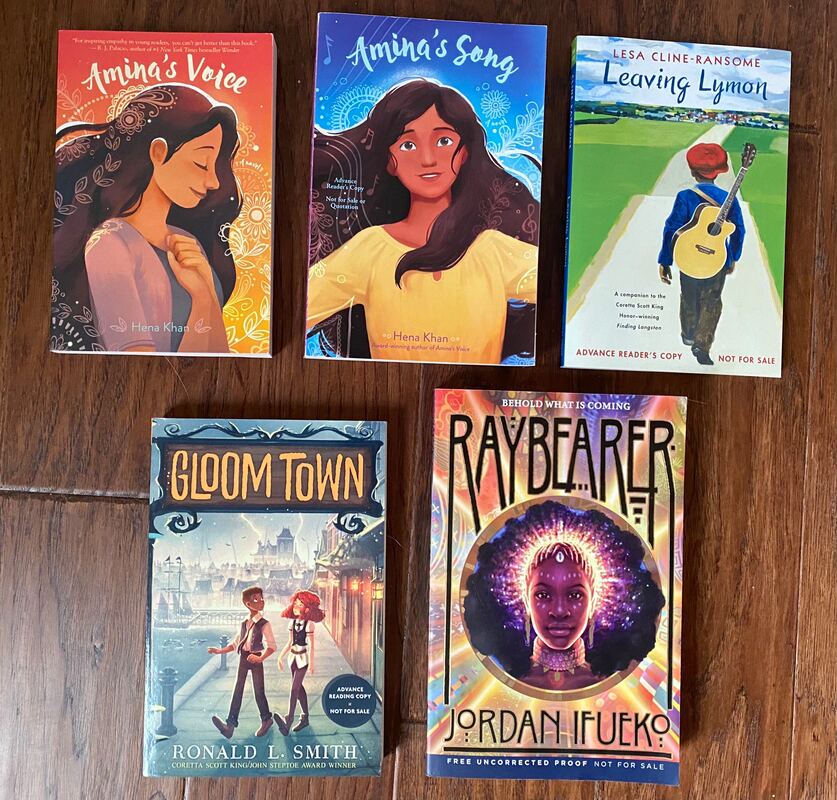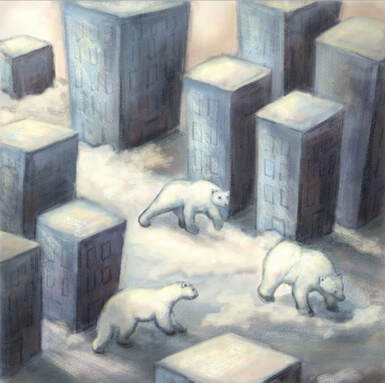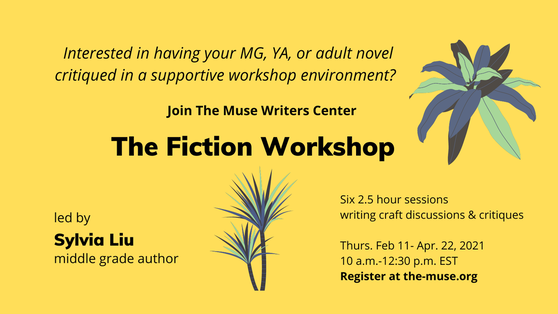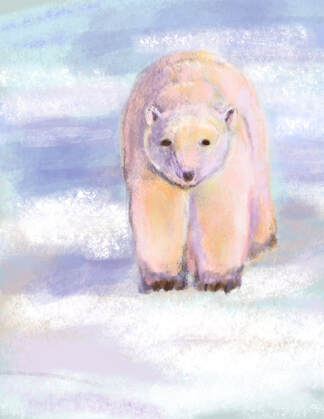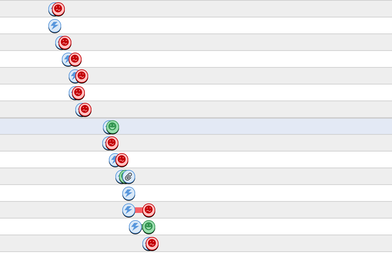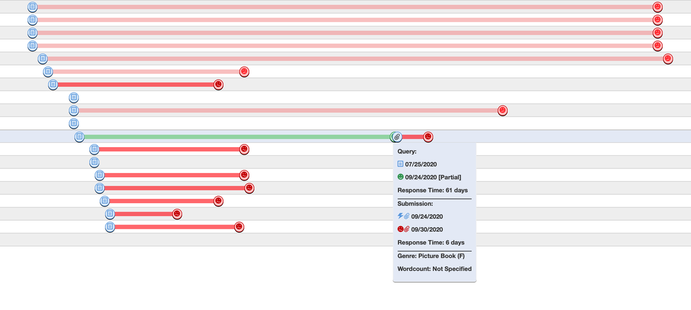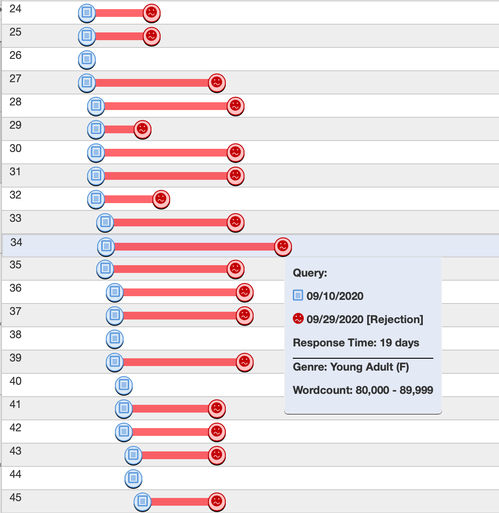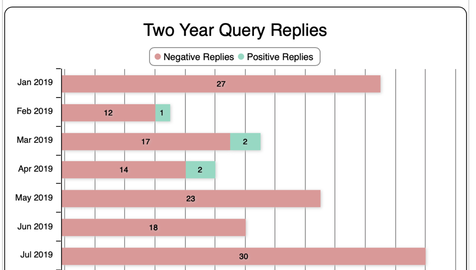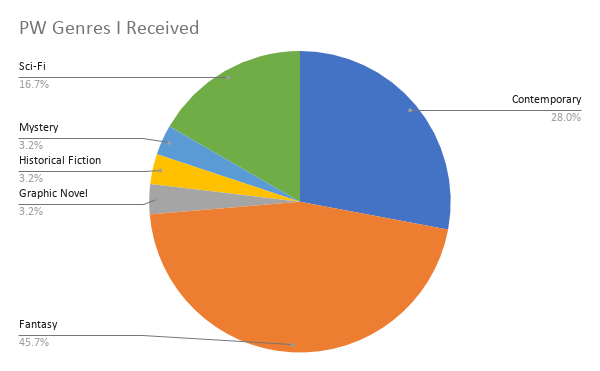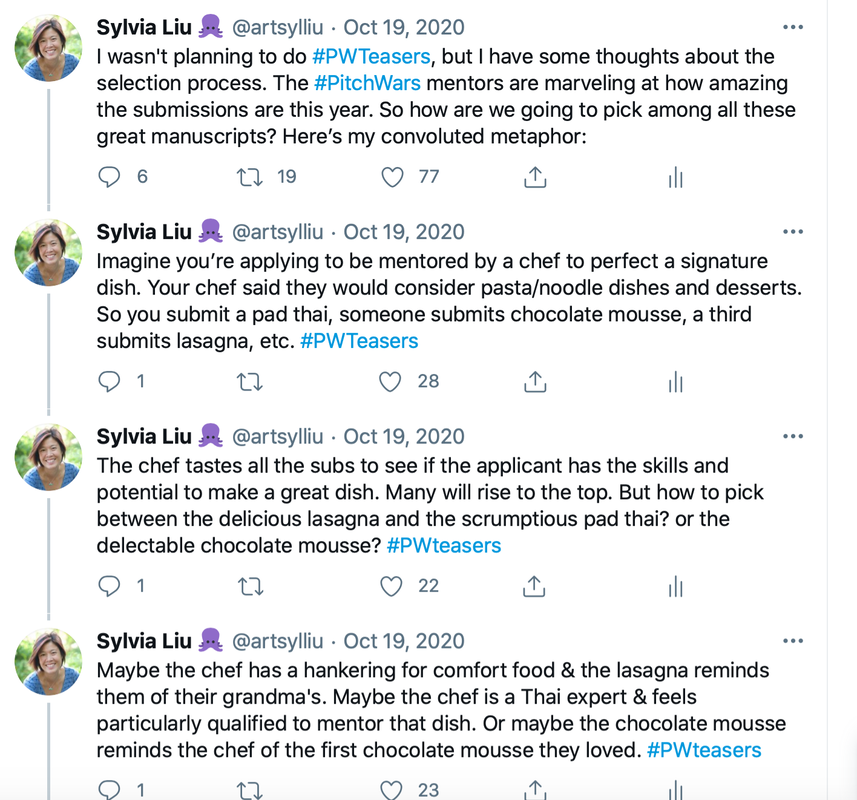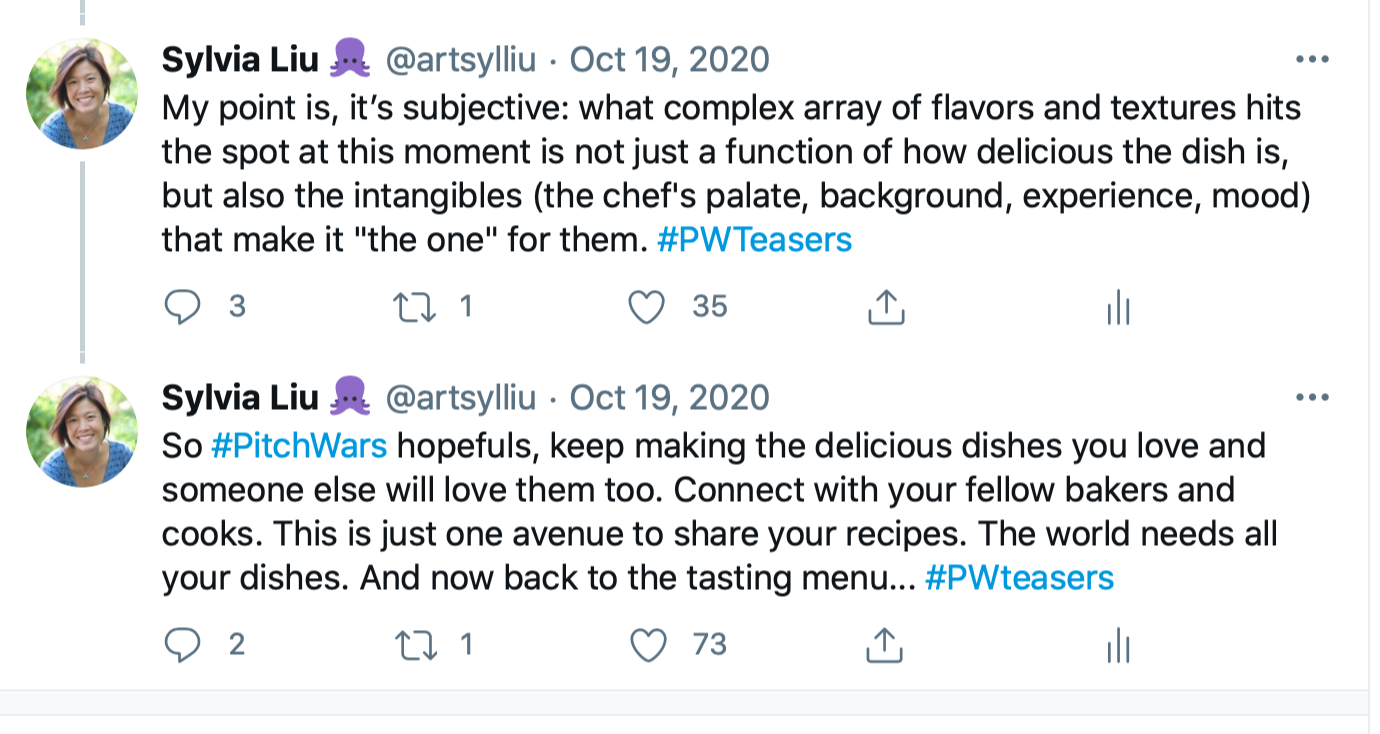|
How do authors take a vague idea and shape it into a story with intriguing characters, plot, and themes? I'm still trying to figure it out, though one thing I've done lately is to brainstorm by using a mind map. On a large sheet of paper (17 x 23 inches), I start with my characters near the center, list their motivations and character traits, and show their connections and tensions with each other. I add plot points, antagonists, and other themes as each idea inspires another element of the story. I jot down ideas on the side, or even notes from craft books that I consult. This is my current brainstorm (blurred to avoid spoilers) of my new project: What are your best tips for organizing your thoughts at the beginning of a writing project? Share them with me for a chance to win a query critique (see giveaway rules below). Upcoming and Past EventsIn the next couple of weeks, I look forward to connecting with other authors and students. Come by and see me if you're in the DC area or in Connecticut: UPCOMING EVENTS 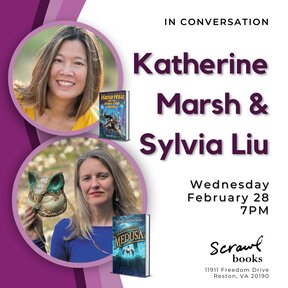 Feb. 28, In conversation with Katherine Marsh, Reston Virginia: I'll be at Scrawl Books on Feb. 28, at 7 p.m., moderating the book release of award-winning middle grade author Katherine Marsh's new fantasy book, Medusa, a delightful adventure about a girl who attends an academy for descendants of Greek monsters and finds out the truth of her heritage. It's like Percy Jackson with a feminist and subversive twist. 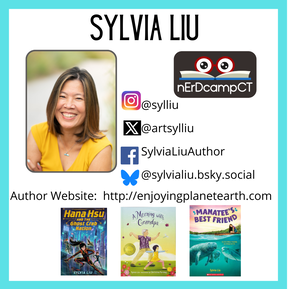 March 2, NerdCamp, Hartford, CT: Join me and other authors, illustrators, librarians, and educators in a day-long unconference to discuss kid lit books. I'm really excited to see some of my middle grade and YA author friends, Alysa Wishingrad (Between Monsters and Marvels, The Verdigris Pawn), Erica George (The Edge of Summer, Words Composed of Sea and Sky), Melissa Dassori (J.R. Silver Writes the World), Nancy Tandon(The Ghost of Spruce Point, The Way I Say It), Lisa Stringfellow (A Comb of Wishes), and Rajani LaRocca (Red, White and Whole, Midsummer's Mayhem, more), among others. PAST EVENTS I love meeting and interacting with students. On Feb. 7, I participated in World Read Aloud Day, where I visited with seven schools around the country to read from my books and answer questions. On Feb. 13 and 15, I visited all classes in first, second, and third grades at Norfolk Academy, in Norfolk, VA, sharing my picture book, A Morning with Grandpa, and doing tai chi with the kids (the school did a nice write-up about it). A Favorite Reader ReactionOver the holidays, I saw my 23-year-old niece, and she made my day when she said the following about Hana Hsu and the Ghost Crab Nation: "I love your book. I still think about it a lot. Sometimes, when I'm facing a dilemma or problem, I'll ask myself, What would Hana do in this situation?" That was truly a moment when I realized how special it is to be an author. Query Critique GiveawayI'm giving away a critique of your query + opening 5 pages (or picture book manuscript under 1000 words). To enter, 1. Subscribe to this newsletter (if you're already a subscriber, great. If not, click on the button below). 2. Reply to this email or to the welcome email (after subscribing) with your best brainstorming or idea-generating tip. Giveaway ends on Monday Feb. 26. This post is a reprint of my email newsletter. To receive posts like this, subscribe here.
0 Comments
A brief note on New Year's resolutions. . .Ha ha. . .what are those? If I had one, it'd be: STOP PROCRASTINATING. And if I'd followed that advice, you would've read this in December. So let's go back in time, about a month ago, and enjoy my end-of-the-year newsletter. . . And be sure to enter my giveaway below of a signed copy of Adia Kelbara and the Circle of Shamans by Isi Hendrix, plus book swag. Cover Reveal! I'm so excited to share the cover of my next middle grade novel, Near and Deer, coming out on Oct. 1, 2024 from Scholastic, about a dog who befriends an abandoned fawn and the girl who tries to keep it together while taking care of the fawn. Here's the adorable cover, art by Diego Salas and design by Maeve Norton: Don't you think this is will be like catnip for kids? If you have a moment, please add this book to your "want to read" list on Goodreads. Book/Media Recs from 2023In 2023, most of my entertainment hours were consumed by a rekindled love of soccer. I grew up watching the World Cup every four years, but ever since last winter's World Cup, I've gotten really into the game. It turns out that following teams or players is like watching a long-running show, with dramatic storylines, twists and turns, heart, and high drama. In case you're wondering, I follow the Premier League, rooting for Tottenham (favorite players: Son and Romero); the U.S. men's and women's national teams (favorites: Pulisic and Reyna); Conmebol (the South American League), especially Argentina and Venezuela; and Inter Miami (because, Messi, of course). Looking forward to the U.S. hosting Copa America this summer and co-hosting the World Cup with Canada and Mexico in 2026! Hoping to get to a game or two in those tournaments; last year, we saw a Premier League game in London (Chelsea v. Everton) and a USMNT game in Nashville (US v Ghana): Other than soccer, these shows & books that stood out for me in 2023: TV SHOWS 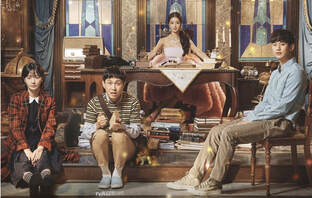 It's OK to Not Be OK. I love this K-drama. The premise of a diva-esque picture book author who writes the most disturbing stories caught my attention, but what drew me in was the central question: can two broken people find happiness together? The characters are complex and interesting (including a well-done autistic character); the tone is dark and whimsical; and the fairy tale metaphors and inventive filmmaking add to the appeal. 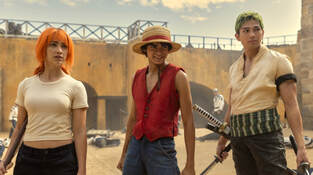 One Piece. I haven't read the source manga, but I really enjoyed this rollicking found-family-of-pirates story about an optimistic boy's quest to become King of the Pirates. Packed with action, charming characters, and set in an odd world of misfits and magic, this is feel-good brain candy. 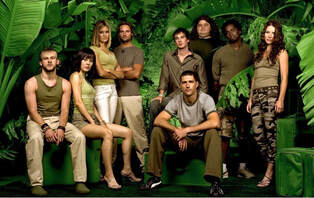 Lost Rewatch. I don't usually rewatch series (except for Battlestar Galactica and Dark Matter), but when I found out my daughters hadn't seen Lost, we began a rewatch. Every episode reminds me of how brilliant the storytelling is, between its immersive and mysterious plot and the brilliant character building.Lost Rewatch. I don't usually rewatch series (except for Battlestar Galactica and Dark Matter), but when I found out my daughters hadn't seen Lost, we began a rewatch. Every episode reminds me of how brilliant the storytelling is, between its immersive and mysterious plot and the brilliant character building. BOOKS 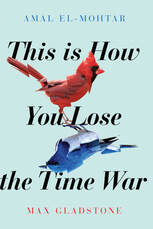 This is How You Lose the Time War by Amal El-Mohtar and Max Gladstone. I loved this sci-fi epistolary novella about rival time-bending agents who fall in love by writing to each other across enemy lines, time, and multiverses. A fun and mind-bending enemies-to-lovers story. 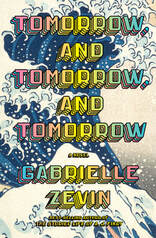 Tomorrow and Tomorrow and Tomorrow, by Gabrielle Zevin. Of last year's popular books, I really enjoyed this unique story of a friendship between two game developers that spans decades of ups and downs, rivalries, betrayals, and more. It's a fun deep-dive into geeky gamer culture as well as a refreshing exploration of the intricacies of a non-romantic friendship. 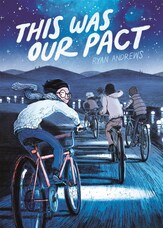 This Was Our Pact by Ryan Andrews. My favorite middle grade graphic novel from last year. Every year, a town floats paper lanterns down a river, and legend has it that they float up into the Milky Way. This year, Ben and his friends vow to follow the lanterns, and what follows is a Studio Ghibli-esque adventure of magic, talking bears, and eccentric new worlds. 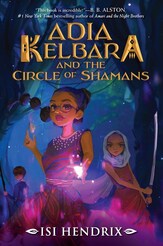 Adia Kelbara and the Circle of Shamans, by Isi Hendrix. This middle grade Afrofantasy holds a special place in my heart, because Isi Hendrix was my Pitch Wars mentee, so I got to see this story develop from its early drafts: a twelve-year-old apprenticing in the kitchens at the prestigious Academy of Shamans must ally with a snarky goddess and a knife-wielding warrior to save her kingdom. #Authorgoal unlocked: blurbs!I was honored to be asked to blurb some middle grade novels last year. It's a thrill to see my name on books I admire (and check out the cool UK cover of Adia Kelbara and the Circle of Shamans). ADIA KELBARA GiveawayI'm giving away a signed copy of Adia Kelbara and the Circle of Shamans, along with some fun swag to go with it. To enter the givewaway:
1. You must be a subscriber to my newsletter 2. Reply to this email (or to the newsletter welcome email if you arrived at this post from somewhere else) with a favorite book or show recommendation. 3. BONUS ENTRY: add Near and Deer to your Goodreads want to read list - just let me know you've done it and I'll give you an extra entry This giveaway ends on Jan. 21, 2024, noon ET. US addresses only. I was insomniac last night, so here are my 4 a.m. thoughts on what makes a successful story. Obviously, what readers love is subjective, but I believe these are three things that we as authors should strive for in whatever genre or age category we write in: Provide readers with an excellent 1. Premise 2. Execution, and 3. Payoff I thought of these after reading This is How You Lose the Time War by Amal El-Mohtar and Max Gladstone (a fascinating example of the power of word-of-mouth, this 2020 book just shot to #1 on Amazon's Best Seller list due to a passionate tweet: Bigolas Dickolas is the Best of Book Twitter; it had been sitting on my Kindle for three years but I read it this week) 1. Premise The premise is the hook that makes a reader pick up the book, or decide they want to pick it up after hearing about it. Whether you're writing a high-concept thriller, a funny graphic novel, or literary historical fiction, a tantalizing premise is what will bring your intended reader to your book. This doesn't mean your premise has to be super high concept; it just has to promise the type of story that your reader loves. For example, here's the premise of two recent favorites: 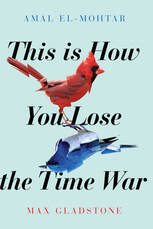 This is How You Lose the Time War by Amal El-Mohtar and Max Gladstone (Gallery/Saga Press 2020, novella): In this mind-bending sapphic sci-fi romance, rival time-traveling agents move across timelines and multiverses in service of the war between their sides and end up falling in love through clandestine missives. 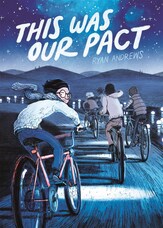 This Was Our Pact, by Ryan Andrews (First Second 2019, MG graphic novel) No one in town knows where the paper lanterns that are released down the river each year go (legends have it they turn into stars), so a group of kids decide to follow them and end up on a magical Ghibli-esque adventure (with a bear). 2. Execution You might have the most intriguing story idea, but the way you execute it will lift it from good to brilliant. This is where readers delight in your turn of phrases, the structure of your story, the art/illustrations, or the flashes of insight and connection. For example, I loved these sentences from Time War: "They will sail together, to a land of monsters and miracles. Currents will bear their massive fish-tailed ships across, freighted with silver and tapestries, with knot work and destiny." or "My vine-hivey elf world, as you say, versus your techy-mechy dystopia" (which also seems like a pithy description of fantasy vs. sci-fi). I also loved both the sheer inventiveness and outrageousness of how the rival spies communicate with each other as well as the epistolary format of parts of the novella. For This Was Our Pact, I really enjoyed the writing ("Did they really journey far into the stars, like the old song sang?") and the art, and how relatable middle-grade friendship themes were shown in the fantastical setting: 3. Payoff For me, the payoff is whether the story sticks its landing or fulfills the emotional promise of the premise. After taking a reader on the storytelling journey, using language or art that brings the story alive, does the story conclude in a way that answers the initial questions and makes readers sit back in delight or contemplation? With a mystery or thriller, it's usually the twist ending that delights the reader. In the case of an installment of a beloved series, it can be the familiar comfort of seeing favorite characters having another set of adventures in the style the reader expects. In a literary novel, it might be the feeling of sitting with a profound truth expressed in the story. In the case of Time Travel, it was the ingenious resolution that made me rethink all the previous scenes (I can't say more without spoiling it). For This is Our Pact, we learn the answer to the initial mystery in the final beautiful illustrated spreads after going through a fantastic journey. The payoff in genre novels (such as fantasy, sci-fi, romance, mystery, thrillers) is often plot-based, resolving intriguing stories with cool endings, but the payoff can also be emotional or philosophical, making the reader feel or think deeply. Of course, my favorite books are those that combine both. Be sure to enter my book giveaway below of Christina Li's RUBY LOST AND FOUND, which accomplishes all of these three elements beautifully. Upcoming Events & Next BookThe last time I sent a newsletter was almost a year ago (ack! I'll try to do better), when my middle grade sci-fi Hana Hsu and the Ghost Crab Nation came out. Since then, I've loved going to schools, book festivals, and generally interacting with readers of the book. Here are some upcoming activities. Please consider joining: Sat. May 13, noon ET: a panel with YA and MG authors Judy I. Lin, Elisa A. Bonnin, and Refe Tuma, Navigating the Debut Year: Insights from Middle Grade and YA Authors (it's part of the online 2023 Nebula Conference, which is $150 to register for 3 days of programming) Sat. May 20, noon ET: a panel with YA sci-fi authors Kate Dylan, Olivia Chad, Claire Winn, and Sarena Strauss, The Future is Here: Cyberpunk, AI, and Augmented Futures in Stories (free) Saturday, Aug. 12, 1:00 - 3:30 p.m. ET, workshop, Submitting to Agents and Query Workshop a 2.5 hour hands-on workshop about the querying process for traditional publishing (for adult and childrens writers), including sharing and class critiques of your queries ($45) Coming Summer 2024 A project that's taken up time these past months is writing and revising my new middle grade novel with a fun animal friendship, Near & Deer, coming out from Scholastic in Summer 2024. Here's the announcement: Giveaway of RUBY LOST AND FOUND by Christina LiI'm giving away a copy of Christina Li's middle grade novel, Ruby Lost and Found, out on May 16, 2023. This is a beautiful story of a girl who reconnects with the memory of her grandfather through a scavenger hunt and a new friendship. I had the privilege and honor of blurbing the book: To enter the giveaway:
1. You must be a subscriber to my newsletter 2. Reply to this email (or to the newsletter welcome email) with a recent favorite book recommendation. (You can also enter to win the book in Christina's separate giveaway on Twitter, which ends on May 16) This giveaway ends on May 19, 2023, noon ET. US addresses only. AHHH... I can't believe after all these years, from the germ of an idea in the Fall of 2017 to today, the middle grade sci-fi book of my heart is out in the world! Hana Hsu and the Ghost Crab Nation is my love letter to all the sci-fi stories I've loved, from classics like A Wrinkle in Time and Andre Norton books to cyberpunk stories like Blade Runner and Altered Carbon to every other book that has sparked my imagination. (I urge you to buy or borrow a copy of the book to see the lengthy acknowledgements section; this book was truly the product of a village!). I have so many people to thank for today, but I'll just do a quick shout out to my family (David, Sammi, and Sarah), my agent Jennifer March Soloway at Andrea Brown Literary Agency, my editors Julie Rosenberg and Gretchen Durning at Razorbill/Penguin Random House, and artist Fiona Hsieh and designer Jessica Jenkins for the amazing cover. Join Me in Tonight's Virtual Launch at 7 p.m. ET Tonight I'll be launching the book online, with the DC-based bookstore, Politics and Prose, from 7-8 p.m. ET (June 21). I'll be in conversation with Newbery Award winner Donna Barba Higuera (THE LAST CUENTISTA, LUPE WONG WON'T DANCE). Sign up for the virtual launch event here. Order the Book and Get SwagIf you're interested in getting a signed copy with fun swag (postcard, bookmark, stickers), you can order the book from my local indie Prince Books. If you've bought the book elsewhere, or requested a library to buy it, you can fill out this pre-order form and I'll send you the goodies along with a signed bookplate. A Giveaway (Annotated Copy)To celebrate my book release, I'm running a giveaway exclusive to my newsletter subscribers. I'm giving away an annotated copy of Hana Hsu and the Ghost Crab Nation, which means you'll get some inside info and tidbits about the scenes, and how the story developed. To enter to win the copy:
1) You must be a subscriber to this newsletter 2) Reply to this email (or if you came from a different source, reply to the welcome email from my newsletter) with a recommendation for summer reading (any age or genre). Giveaway ends on Tuesday June 28, 2022. We're entering Year 3 of the global pandemic, Russia invaded Ukraine, publishing is going through editorial burnout, and almost everyone I know is in a state of stress, either at a high- or low- level. It's hard to dig into our creative wells and find the mental space to write or make art at a time like this. (It's also why my bimonthly newsletter has turned into a once-every-few-months one). So how do we do it? How do we press on? I don't have any deeply insightful advice, other than give yourself a break. Don't beat yourself up if you need a short or long pause from creative work; if you need to veg in front of the TV; or if it takes over two years (ahem) to write your latest manuscript. Take deep breaths or long walks. Here's a quote I like from my daughter's daily Zen calendar that I like: I'm curious: what are your best de-stressors? what are some good shows you've watched lately? Recently, I've enjoyed Bridgerton season 2, Abbott Elementary, Mr. Robot, and now I'm watching The Silent Sea (a Korean sci-fi). Cool Book News: My Dad's Memoir is Out!An exciting thing happened in late January. I helped my dad, Bernard Liu, publish his memoir, The House Arrest of Zhang Xueliang: A Memoir of Growing Up with China's Most Famous Political Prisoner (at the age of 88!). He had published this memoir with a Chinese publisher in 2018, but we had kept the English rights. Here's the cover (design by Robin Locke Monda): Here's the back jacket that describes his extraordinary story: Working on this book, I learned a lot about self publishing (from buying ISBNs to registering copyrights to hiring copyeditors and designers). Maybe one of the coolest things was being able to hit "publish" and having the book available online within hours. Instant gratification! Here are the buy links: Amazon | Barnes & Noble Hana Hsu Updates (on sale June 21) 3. Pre-Order Swag My pre-order campaign will include a signed book (if ordered from Prince Books, a signed bookplate if bought elsewhere), a bookmark, and some other flat goodies. I'll announce the campaign formally in early May, but if you want to get a jump-start on pre-ordering, here's the link to the book through my indie bookstore, Prince Books. Keep a copy of your receipt to send in when the official campaign starts. Here's a sneak peak at the bookmark: You can also hit this button to pre-order: And if you haven't done so, please add Hana Hsu to your Goodreads "want to read" list. This helps my publisher see the interest in the book. Thanks so much! this is a reprint of my semi-regular newsletter. Subscribe here to get this in your in box.
I start most of my novels as a pantser, but at some point, I pull out all my organizational tools and start plotting and planning. As a visual person, I like exploring plot and scenes in visual ways. Old School Tools In early November, I spoke with Emma Kress on Instagram Live about some of my favorite low key tools, like highlighter pens, Post-it notes, index cards, and poster boards. Check out our 15-minute talk, and while you're at it, bookmark Emma's page for other excellent craft chats she hosted during NaNoWriMo. These are the tools I talked about: (1) a plot arc chart, where I draw an arc and place external plot points on the outside and internal ones on the inside; (2) Lisa Cron's scene cards from her book Story Genius (see this blog post explaining them); (3) Kate Messner's Big Revision Chart; and (4) a poster board with different colored Post-Its for different POVs. (my plot arc chart from Hana Hsu and the Ghost Crab Nation - coming in June) (my index cards from my current WIP) (my board with POVs of my current WIP, 2 POVs in blue and yellow, special scenes in pink) Trello Boards What I really want to talk about is Trello Boards. It's an online project management website where you can organize your tasks and To Dos and collaborate with work colleagues on joint projects. The Usual Use: Project Management Here's a screenshot of my To Do board. Each of the columns can be moved, and there are more columns to the right as you scroll. Each card can be opened to include more details, like lists or links. I have a mix of subject columns and day-by-day columns. When you're done with a task, you can archive the card, or move it to a "Done" column. Trello Board for World Building I like to use Trello boards for world building. I treat my board as a Wikipedia where I gather or make up all the information about my world. For Hana Hsu, I wrote a bunch of fake news articles for my future world set in 2053. They were included in my initial draft, but by the time it got to the submission stage, I had already taken them out. In the final story, there are 2-3 line news snippets, but the full articles exist on my Trello board. I included another column for links to the real life articles that inspired bits of the story and have other columns for different aspects of the world. Here's my Hana World Building board (more columns as you scroll to the right). If I click the first card under Fake News, this fake article I wrote opens up: If I click on the card "Overview: Corporate Control," I get this write up that I did: As you can see, in each card, you can add links, checklists, etc. The sky's the limit as to how you can use your Trello boards. For example, I also use them to do my character work: Hana Hsu Cover!Earlier this month, I revealed the cover for my middle grade sci-fi, Hana Hsu and the Ghost Crab Nation, coming out on June 21, 2022. Isn't it so cool? I love pulling it up on my phone and staring at it. The amazing art is by Fiona Hsieh, and the design is by Jessica Jenkins. Feel free to pre-order your copy now! (save your receipt for my future pre-order campaign) E-ARC and Pre-order Giveaway!To celebrate the cover reveal, I'm giving away two prizes (to 2 people): (1) a digital e-ARC when it is ready, and (2) a pre-ordered copy of Hana Hsu. To enter: 1. You must subscribe to this newsletter. (If you reached this link from an outside source, click here: 2. Reply to this email (or to the welcome email if you just subscribed) with your one word intention for 2022. Mine will be "Focus" and "Breathe" (ok that's two words; feel free to add more than one word, if you can't decide) 3. Bonus entry: add Hana Hsu to your Goodreads "want to read" list (and let me know you've done so in your reply) 4. Giveaway ends on Friday, Dec. 17, 2021. Thank you, friends, for hanging out with me on my writing journey. Hope you have a wonderful holiday season and a healthy and happy new year! This is a reprint of my email newsletter. To subscribe, click the button above.
Writing dialogue is hard, and it's an area I still work on. Here are some tips I've found helpful to make dialogue feel engaging and believable. 1. Eavesdrop Sit in a cafe or drive a carload of kids and listen to how they speak. You won't want to include the latest slang (because it will become outdated), but you'll get a sense of the different ways people talk (their cadence, voice, how they don't talk in complete sentences, are casual, etc). 2. Less is more: verisimilitude not exactitude Even if one of your characters like to talk a lot, writing dialogue isn't the same as transcribing words. Remove excess words and sounds such as "um" and "ah." This results in more crisp and concise dialogue, which will convey the essence of the conversation. 3. Give your characters distinctive voices Pay attention to the word choices and sentence structures of each character, to give them distinctive voices. For example, you can have one character never speak with contractions, which would give them a more formal voice. Or you might give a specific phrase to only one character. 4. Be sparing with dialect, stuttering, or other unusual speech patterns If your character has an accent, stutters, lisps, or otherwise speaks in a unique manner, don't overdo it when writing their dialogue, because it can be distracting or a stumbling block for the reader. You can add a slight touch of the unusual speech to give the reader an idea that this is how the character speaks, or describe it in the narrative, if it is something the POV character would notice. 5. Beware of floating dialogue A common issue I see in students in writing workshops is what I call floating dialogue: a big chunk of back and forth dialogue, without grounding action or description. Here is an excerpt of my recent book, Manatee's Best Friend. Start reading at the second paragraph that begins, "Mom puts down the brush." If I had written this scene as "floating dialogue," it would read like this: As you can see, the scene loses nuance and the characterization of both Mom and Becca. In first drafts, dialogue often comes out "floating," but in revisions, you can layer in the other elements of the story. I'm a Pitch Wars Mentor!I'm excited to announce I'm a middle grade mentor for Pitch Wars again this year! Pitch Wars is a mentoring program where published/agented authors, editors, or industry interns choose one writer each to spend three months revising their manuscript. It ends in February with an Agent Showcase, where agents can read a pitch/first page and can request to read more. Writers can apply to four mentors with a query, synopsis, and first chapter. I had a great time mentoring the talented Isi Hendrix last year, for her Afro-fantasy MG. She had a tremendous showcase experience, resulting in signing with two agents, one in the U.S. and one in the U.K.! Mentors will post our wishlists on or around September 12, so watch my Twitter feed for the announcement, if you're interested. I'll be posting my wishlist on my blog. This was a reprint of my email newsletters. To subscribe to them, hit this button:
On August 3, my middle grade novel, Manatee's Best Friend, was published by Scholastic! I had a wonderful week of celebration on social media and at home.
I'm really grateful to be able to share this story of 12-year-old Becca Wong Walker, who must overcome her shyness to fight for her manatee friends, while also dealing with complications of a viral video and new friendships. If you have a child in your life (8-12 years old), please consider sharing the book with them. A Dolphin Video
To celebrate the release, I chatted with MG author Kate Albus (A Place to Hang the Moon) on IG Live, In our conversation, I described an encounter my friends and I had with dolphins who visited our boat. Here's the video of those amazing moments:
The Friends We Made Along the Way
It's a surreal experience to have a book come out to the world. It lived for so long as a series of 1s and 0s in my computer, and now it's a book with an adorable cover (thanks to artist Scott Dorman and designer Stephanie Yang). The moment I held the actual book was truly special (check out my unboxing video).
But even more awesome is the community of writers, friends, and family who have supported me throughout the process. Instead of recapping all the names, I'll post my acknowledgements from the book. (Ever since I became an author, I've loved reading these. Don't you?).
After I wrote this, I continued to make great writing friends, especially other debut authors in 2021, mentors and mentees in Pitch Wars, and more.
A Gallery of Celebration
Here are some pictures of this memorable week.
I got lovely gifts from friends and family:
I took my book for a walk on the beach to get a photo for the release announcement:
The evening before the release, my IRL CP group (insanely talented MG, YA, and adult authors) met and we had cake and champagne.
And photos at the bookstore (signing pre-orders, visiting the store on release day, and book signing a few days later)! (Prince Books in Norfolk, Virginia)
All in all, it was a wonderful experience. I received such an outpouring of love on social media, and I thank each and everyone who helped cheer on this book. ?
if you want to read more content like this, please sign up for my newsletter:
In revising my middle grade science fiction novel, Hana Hsu and the Ghost Crab Nation (Razorbill June 2022), someone on Clubhouse gave me the best revision tip: Have your computer read back your words to you. I've found this really helpful because it lets you: (1) identify typos that are easy to hear and hard to see, (2) hear the flow and cadence of sentences, and (3) experience the book in a different sensory format. It's almost like hearing an audiobook. How do you do this? I have a Mac laptop, but I assume this also works in Windows. 1. In Word, insert your cursor where you'd like it to start reading, go to "Review," then click "Read Aloud." A pop-up window will appear that lets you adjust the reading speed and the voice (male or female): 2. In Scrivener, go to "Edit" --> "Speech" --> "Start Speaking" To change the default voice and speed, go to your computer's System Preferences --> "Accessibility," --> "Speech": 3. On your phone, I've used the app Natural Reader to have my phone read a file, but it doesn't let me immediately revise or correct the manuscript. Have you ever done this? What other good revision tips do you have? Book News: Manatee's Best FriendIn one month, on August 3, my middle grade novel, Manatee's Best Friend, will come out from Scholastic! I'm excited to share my story of a shy girl who finds her voice to save manatees. If you pre-order the book from my local indie bookstore, Prince Books, you'll get an autographed copy plus an adorable bookmark. Giveaway: Query Critique + 10-page giveawayTo celebrate my upcoming book, I'm giving away a query critique + a critique of the first ten pages of your novel (MG, YA, or adult), or full picture book manuscript critique (under 1000 words).
To enter: 1. You must subscribe to my newsletter (click the button below if you came to this post from an outside link) 2. Reply to this email (or the welcome email once you subscribe) and let me know a good revision tip that has helped you. Giveaway closes at the end of the day, July 16. Hi all. This is a combined April/May newsletter because the past two months have been very heavy, news-wise, and I've had a lot going on (good stuff). I've also realized I bit off more than I could chew by promising a monthly newsletter, so I will send these out every other month from now on. I usually write about books, but today I'll share my favorite shows and movies from the last year of pandemic watching. Be sure to enter my giveaway below of a bunch of books. TV Shows  1. Ted Lasso. Our whole family loved this show. It's hilarious and full of heart, a fish-out-of-water story about an eternal optimist of a football coach hired to lead a soccer team in England with no experience. The set-up sounds cheesy, but the execution is fresh and funny with interesting and quirky characters. The show is laugh-out-loud funny and full of goodness, the perfect antidote to last year. (Apple+ - if you've bought an Apple product recently, you get a year free of Apple+) (for teens and up, some explicit jokes/conversations) 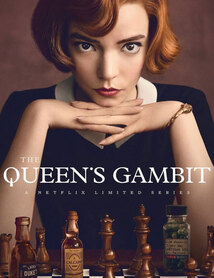 2. Queen's Gambit - I enjoyed this so much I watched it twice, which is rare for me. The story of Beth Harmon, an orphan girl and chess genius who battles addiction and achieves the highest levels of success in the chess world with the help of friends she makes along the way, is thoroughly gripping. It's always fun to root for a woman who succeeds in a man's world, and Queen's Gambit does this in a smart and stylish way, and, refreshingly, never puts Harmon in sexual danger. The historical costumes were amazing (to the point where my husband commented on the fashion) and a fun Easter egg was seeing two child actors from the 90s all grown up (Thomas Brodie-Sangster, the boy from Love, Actually, and Harry Melling, who played Dursley in Harry Potter). (Netflix) 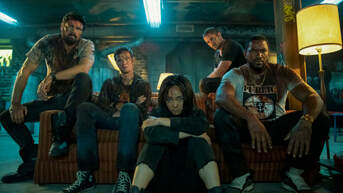 3. The Boys - A wildly entertaining story of corrupt superheroes who cash in on their fame and the rag-tag vigilante team of "The Boys" (and girls) who try to take them down. My college roommate Sarah Boyd directed one of the episodes (with an unforgettable scene in a lunatic asylum) and is slated to direct the two-part finale of Season 3. The show can be shocking in its violence, but is thought-provoking and so much fun. (Amazon Prime)  4. Casa de Papel (Money Heist) - A Spanish-language series about the perfect heist and the motley crew of robbers, misfits, hackers, and toughs who pull it off. The show follows the criminals, hostages, and detectives in a high-stakes cat-and-mouse game and is full of flawed characters I loved to hate, and ones I simply loved. The plot twists are tricky and genius, and it was fun watching the show in Spanish (English dubbed version available too). (Netflix) 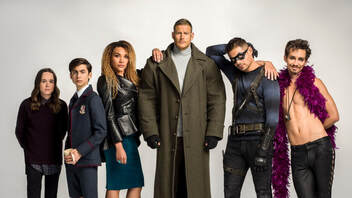 5. Umbrella Academy -Another show with an ensemble-cast of misfits (apparently my favorite kind), this time a family of super-powered people who deal with their dysfunctional upbringing while averting world-ending catastrophe. One of the siblings, played by Elliot Page, discovers a secret about themself that shatters the family. Add some time-traveling to the 60s and mind-bending plot twists, and you've got a winner. (Netflix)  6. Schitt's Creek - I finished the last season of Schitt's Creek early in the pandemic, and it was the exact right time to binge watch this hilarious and heartwarming story of a wealthy and self-absorbed family who end up living in a motel in a small town in the middle of nowhere. Not only did Schitt's Creek have comedic greats like Eugene Levy and Catherine O'Hara and the most heartwarming love story ever, it delivered amazing character arcs and a lifetime supply of memes for every occasion. (Amazon Prime) 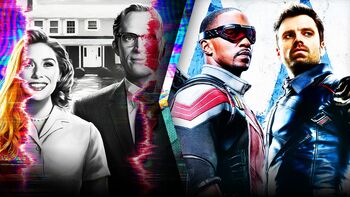 7. Wandavision & The Falcon and the Winter Soldier. These two Marvel shows are so different in tone and theme, but I love them both for expanding the Marvel universe in TV-series format. Instead of a 2.5 hour movie, we get many more hours to fall in love with these characters. I loved the innovative storytelling device in Wandavision (following sitcom formulas from the 1950s on) and its in-depth exploration of grief. In TFATWS, I was sucked into the classic action-adventure and camaraderie of a well-done Marvel movie, the exploration of racism, and the incredible chemistry between the two leads. (Disney+) 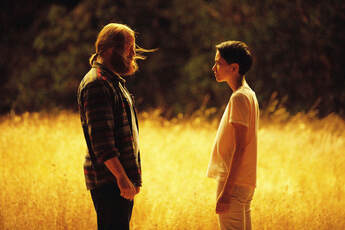 8. Devs - Another college roommate recommended this thought-provoking and moody sci-fi show exploring heady existential ideas about memory, experience, nostalgia, and what people will do to hold onto those they love. I came for the plot and ideas and stayed for the vibes. (Hulu) 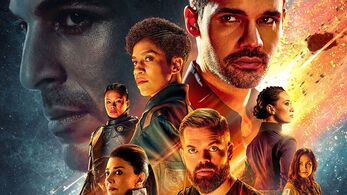 9. The Expanse - This is my favorite sci-fi series (maybe even better than *gasp* Battlestar Galactica). It is epic space opera with intricate interstellar politics (between Earthers, Martians, and Belters, the three factions humans have split into), drama on large and intimate scales, and the classic question of how people react to first contact with an alien species. (Amazon Prime) Movies I watched a number of thoughtful and powerful movies last year, like Parasite, Judas and the Black Messiah, BlackkKlansman, and Jojo Rabbit, and solid movies I'd missed like The King's Speech and The Imitation Game, but here are a couple that were plain escapist fun (and a bonus documentary): 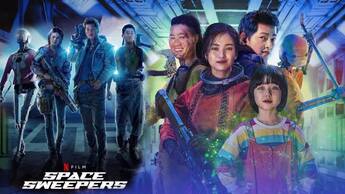 1. Space Sweepers - This action-packed Korean sci-fi is a wild ride. I loved this story about space scavengers inadvertently forced to save Earth despite their mercenary instincts. Plus it has found family, an adorable kid, epic space battles, multilingual conversations, environmental themes, and tons of heart. (Netflix) 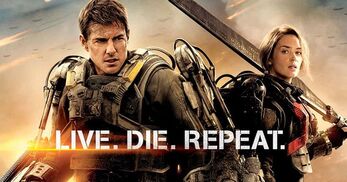 2. Edge of Tomorrow - I'm not a huge Tom Cruise fan, but this is an underrated gem of a movie, with an action-packed Groundhog-day-style story about a major sent into battle against an alien invasion who gets stuck in a time loop where he has to relive the day he dies over and over again, trying to figure out a way to defeat the undefeatable aliens. 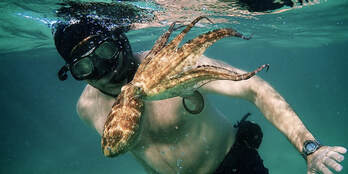 3. My Octopus Teacher - This is one of my favorite documentaries, about a man who spent a year free diving every day in the kelp forest off the coast of his home in South Africa and getting to know an individual octopus. The world he discovers and their relationship is moving, beautiful, and utterly touching. (Netflix) A Multi-Book Giveaway
I'm giving away the above-batch of fun picture books and middle grade books to one lucky winner: BULLY by Jennifer Sattler; JULES VS. THE OCEAN by Jessie Sima; SAUCY by Cynthia Kadohata, illustrated by Marianna Raskin; A PROBLEMATIC PARADOX by Elliot Sappingfield; and THE WUNDERLING, by Mira Bartók. To enter to win: 1. You must be a subscriber of my newsletter (use the button above or below to subscribe), and 2. Reply to this email with a favorite TV show or movie you watched this past year. If you arrived at this post from an exterior link, reply to the welcome email after you subscribe. I'll pick a winner (U.S. addresses only) after May 15, 2021. Writing novels involves juggling so many things. One small task is to give your secondary (and walk-on) characters a memorable entrance. Here are some tips on how to do this. 1. Introduce them one at a time If your main character has a lot of friends, or is in a group situation, nothing is more confusing than throwing out a lot of names without context. For best effect, introduce characters one at a time, with specific descriptions or actions to make each character stand out. Maggie Stiefvater does this really well in The Raven Boys, a YA fantasy with an ensemble cast: a psychic town girl named Blue, and four private school best friends, Gansey (a Golden boy), Ronan (tortured soul), Adam (loyal friend, scholarship student), and Noah (quiet watchful one). When Gansey's car breaks down at the beginning of his first chapter, two of his friends come to rescue him: Stiefvater paints vivid and distinct personalities, through both description (type of car Ronan drives, quality of Adam's tie) and action (Ronan slamming the door, Adam and Gansey having an unspoken rapport). She also introduces Ronan with enough description so the reader forms a mental picture of him before Adam appears a few sentences later. 2. Describe your characters with interesting and memorable details. In Renegade Flight, a futuristic story about a girl who ekes into a prestigious pilot-training academy (to pilot fighting mechas), Andrea Tang does a great job introducing the MC's rival: In a few phrases, we meet this remarkable girl with attitude and style, as well as a sense of the MC's feelings about the girl, a mixture of admiration and maybe intimidation. 3. Describe characters from the perspective of the POV character and show their relationship. Instead of a neutral description, show us how the narrator feels about a character, or the nature of their relationship. A great example is The Verdigris Pawn, when Alysa Wishingrad introduces Himself, the ruler of the kingdom and father of Beau, one of the main characters: In this short paragraph, we see how cold and judgmental Himself is, and how Beau suffers under his father's scrutiny. In one paragraph, we already get a sense of the start of Beau's character arc, including his wound. Another example is discussed in the article, "The Raven Boys - Third Person Voice" which compares how Gansey is described by Blue: and by Adam: The reader forms a picture of Gansey, but filtered through the eyes of the other characters. 4. Even minor walk-on characters can shine. While you don't have to create three-dimensional personalities for minor characters, it's still worth bringing them to life. Here's an example from Pachinko by Min Jin Lee. Like the examples above, we get a picture of the matchmaker told from the perspective of one of the other characters. Giveaway Time! A Query Critique
I'm bringing back the popular query critique as this month's giveaway. To enter, 1. You must subscribe to my email newsletter 2. Reply to this email (or if you're a new subscriber, to one of the welcome emails) with a current favorite TV show or movie. (Can you tell I'm crowdsourcing my entertainment recs?) I'll pick a winner after Friday, March 19, 2021. One of the best ways to improve your writing is to read widely. People say you should read at least 100 books in your genre and age category, and it's great advice. I love reading as a reader, but here are some ways to read as a writer, to actively analyze and learn from the books you love. 1. Copy the Great Ones In traditional painting, students learn by copying the masters. By replicating the colors, compositions, and brushwork, artists learn what works. The same thing holds true for authors. Whether you write picture books or novels, a great exercise is to open a blank document and re-type a picture book, or in the case of a novel, the first chapter (or at least 500-1000 words). When I was learning children's illustration, I thumbnailed existing books. Here's my thumbnail of a super cute 2008 picture book, Jumpy Jack and Googily, by Meg Rosoff, illustrated by Sophie Blackall: I've copied the beginnings of many middle grade novels, and it really helps me understand how different authors construct their sentences and the rhythm of their voices. One insight I learned, for example, was sentences can be more sophisticated than I was writing. I also add information like chapter word-count and POV. Here's the beginning of a re-type of Tae Keller's The Science of Breakable Things (Tae is my Author Mentor Match mentor who just won the Newbery Medal for her amazing book When You Trap a Tiger!) (To find the word count of most books, check out Accelerated Reader Bookfinder) 2. Pinpoint the Midpoint When plotting, it's helpful to know the midpoint scene. In Story Engineering: Mastering the 6 Core Competencies of Successful Writing, Larry Brooks describes the midpoint as the point when new information changes the understanding of the reader or the character. It shifts the context or the story, giving the MC new impetus to solve their problem. Something I like to do is take books and literally open them to the halfway mark (e.g. in a 280-page book, open to page 140, on a Kindle, slide to 50%). Read the scene and see if you can identify how it's the midpoint of the story. Nine times out of ten, that scene is a key one: in a YA romance, it might be the first kiss (e.g. When Dimple Met Rishi), in a thriller, it can reveal important information (e.g. in Scott Westerfeld's Uglies, Tally learns there are people who grew up outside of her civilized world. In this book, there's an even bigger reveal at the 60% mark, which is probably the true midpoint, which shows that you don't have to be rigid about it). 3. Reverse Outline your Favorite Book Take a favorite book and summarize each chapter. See if you can identify key plot points, the purpose of each chapter, and how the chapters work to construct the story. Here's part of my reverse outline of a favorite MG, City of Ember by Jeanne DuPrau: By engaging with books as a writer instead of a reader, you can figure out more easily how a story works. Giveaway: A Stack of ARCs To keep you reading like a writer, I'm giving away this stack of ARCs (to U.S. addresses only): Amina's Voice (2020) and Amina's Song (2021) by Hena Khan, Leaving Lymon by Lesa Cline-Ransome (2020), Gloomtown by Ronald L. Smith (2020), and Raybearer by Jordan Ifueko (2020). To enter,
1) you must be a subscriber of my newsletter, and 2) reply to this email with a song you're enjoying. In late 2020, "Congregation" by Low was in heavy rotation, and now I'm enjoying "I'm Not Your Hero" by Tegan and Sarah. 3) Bonus entry: add my MG sci-fi Hana Hsu and the Ghost Crab Nation to your Goodreads To Read list (it's a story about a 12-year-old girl who fights a high tech conspiracy with the help of hackers, bird bots, and a qi gong master). If you arrived at this post from another source, you can subscribe with the button below or with the tab on the upper left, and reply to one of the welcome emails. The Secret to Networking: the Four C's When you hear networking, it sounds like business-speak, doesn’t it? All transactional, like a salesperson trying to expand their client list to sell another widget. But here’s the thing: it’s really another way of saying, no writer or artist can do it alone. As a creative person, if you want to improve your craft and become traditionally published, and not fall into despair along the way, the key is to find your community. Because I like alliteration, here are my four C’s for networking and finding community: Curiosity, Compassion, Curation, and Connection. Be sure to enter my giveaway of $100 for any class or conference of your choice (details below)! 1. Curiosity It all starts with being curious and open to new ideas. Instead of approaching networking as a way to develop your brand or sell books, think of it as connecting with all the interesting people. One great thing about social media is finding people who share your interests. I have a private Twitter list called “always interesting” that includes mapmakers, ocean explorers, funny AI accounts, and esoteric historians. When you keep an outward focus, you can’t help but enrich yourself. The TV show Ted Lasso has a pivotal scene about this, but I won’t ruin it (HOT TIP: go watch Ted Lasso ASAP, it’s one of my top shows of 2020, hilarious & full of heart). 2. Compassion It’s been a tough year. You never know what someone is going through, so a good rule is to be compassionate. Put yourself in the other person’s shoes. This can be difficult when we face deep injustices and urgent issues (environment, politics, Covid-19, racism/sexism/etc), but the point is, you don’t have to engage with toxic people. Uplift and surround yourself with those who are making the world a better place; find the people who will support you and your creative efforts. 3. Curation The corollary to being curious and thinking of others is you’ll want to curate your social media. Keep the good stuff in and leave whines or vents in drafts. We’re all human, so HOT TIP: find at least one trusted friend with whom you can be as petty and snarky as you want, in private channels. 4. Connection While the above can help you network, how do you actually find your people? Here’s a rundown on some great writing & illustrating communities (mostly kid lit, some cost $ and others are free, and look at all the Cs!): CLASSES In addition to learning craft, classes let you connect with others at the same stage in your career. Some of my best CPs have come from classes. I highly recommend:
CONFERENCES Pre-pandemic, I loved connecting with writers through conferences. Most have moved online. A few favorites:
CRITIQUE GROUPS/PARTNERS The best way to improve your craft is to get honest feedback. Some places to find CPs:
CONTESTS & MENTORSHIPS A great way to connect with others is by entering contests or applying for mentorships and supporting fellow applicants. For example:
COMMUNITIES Here are some of my favorite creative communities:
Finding community doesn't require a huge group. Having just a couple good writing friends and CPs can be enough. So much of building connections is informal. I've made friends on Twitter (one of my new author friends and I bonded over our love of Battleship Galactica), giving feedback to applicants to AMM or PW, doing writing sprints in Slack groups, and more. Also, don't get hung up with connecting with people who may be "important" or who could help you in your journey. The people who will grow with you are truly the best networks. In August I wrote about my PB critique group & how we all started out unpublished and un-agented and now most of us are both. (I connected with them 8 years ago after seeing the FB posts of a writer who seemed to be my twin in outlook on life - Teresa R! - I asked her if she was in a writing group, and the rest was history). To read more from my January newsletter, including a roundup of my favorite 2020 reads, go to The Secret to Networking: The Four C's. To receive notice of new content, subscribe to my newsletter:
For some time, I've wanted to share tips for researching and querying agents based on my experience and what I've gleaned from friends, authors, mentors, and years of compiling articles for Kidlit411. For the basics, check out YA author Angie Thomas's recent Twitter thread and Kidlit411's Submissions: Agents & Editors and Query Letters. Today I'll give some advanced tips for finding good agents, a smart query strategy, and due diligence once you get an offer. Three resources are especially helpful: Query Tracker (QT), Publishers Marketplace (PM), and Twitter. QT has a free version, but the paid subscription ($25/yr) gives you more powerful tools. PM is pricey, but it's worth paying the monthly fee ($25) once during the month you're researching agents. Be sure to enter my query + 10-page (or full PB ms under 1000 words) critique giveaway below! How to Find Agents to Query 1. Make an Initial List: Your first step is to identify agents who represent the types of stories you write. Some sources: Query Tracker (search by genre, category & who's open to subs); Manuscript Wish List (website that compiles agent wishlists); Literary Rambles (interviews with kid lit agents); my Twitter list of kid lit agents; Heather Ayris Burnell's Monster List of Picture Book Agents; market survey books (like Writer's Market 2020 or SCBWI's The Book); and more listed in Kidlit411's Submissions page.
2. Narrow down the list: To find agents who might be a good fit, read interviews, search #MSWL on Twitter (agents post wishlists using this hashtag), follow agents on Twitter, attend conferences or workshops (if possible), and ask fellow authors.
3. Weed out schmagents: Sometimes you'll run across an agent who is predatory (e.g.charges fees); does not adhere to acceptable practices (e.g. pitches clients in a mass email); or is simply not that good (e.g. at an agency that has a reputation for training agents poorly or worked many years with few sales). To find out whether an agent is legit:
A Smart Query Strategy Many have given this advice, and it works: query in small batches (7-10) agents at a time. Wait to hear (or not) from them and revise your query package accordingly. Radio silence means your query or first pages need work and champagne rejections can help you revise. Once you get requests for partials and fulls, be patient and wait for feedback to see if you need to revise your manuscript before the next round. The idea is to improve your query and manuscript until you land an agent. Specifically:
These QT timelines are also helpful to let you know where the agent is in their reading and if they go in order. Each of the entries is clickable and will show the submission date and agent response. For example, if you see agent responses stopping in August 2020, and you submitted in October, you know you have a bit to wait. If the agent has rejected every ms before and after yours but your entry has not been acted on, it might be under consideration. For example, this agent rejects fairly quickly but skips entries (#s 26, 38, 40, 44 are presumably maybes): Premium QT has all sorts of other fun reports, like rejection rates by genre or a two-year chart showing responses: (Note: QT only tracks queries self-reported by other QT users; as a result, it's a partial window into an agent's in box). The point of this strategy is to not blow your chances by sending your first, possibly ineffective query to all of the agents on your list. If they all result in rejections or radio-silence, that manuscript is rendered effectively un-queryable and you won't know what needed work, your query or your manuscript. Bottom line: If at first you don't succeed, at least fail smarter. The key to this strategy is PATIENCE. I know how tempting it is to send a query out sooner than a manuscript is ready (I've done this!). By using this strategy and revising based on feedback, you will get to a point where your query package is strong enough to consistently get requests. At that point, you can query more widely (or at least make sure your top choices have your query, because it's bad form to send new queries once you receive an offer). While you're waiting to hear back, work on your next project. Due Diligence When you get an offer, it's time to dig even deeper and do your due diligence.The first step is to have a call with the agent to get to know them better and find out if you might be compatible (e.g. Beyond the Basics for the Agent Call, 10 Questions to Ask When Offered Representation by a Literary Agent). As part of that call, ask for client references and contact them.
FINAL NOTE: All of this takes time and patience and assumes your manuscript is ready to query (get critiques & revise!). The more carefully you research an agent at all stages, the more likely you'll get a positive outcome. Was this post helpful?
If so, I'd be grateful if you share this post and add my forthcoming MG books to your Goodreads lists (Hana Hsu & The Ghost Crab Nation and Manatee's Best Friend). To receive notice of new posts, please subscribe to my email newsletter: This fall, I'm a mentor in Pitch Wars, where middle grade, young adult, and adult writers apply to be mentored by established authors. If chosen, the mentees will revise their manuscripts for three months to prepare for an agent showcase in February 2021. We announce the mentee selections on Nov. 7 and I can't wait! As a middle grade mentor, I read 185 applications, which consisted of a query, a synopsis, and the first ten pages of the manuscript. The breakdown by genre is shown above. My two big takeaways from reading these applications are (1) it's all so subjective and (2) beginnings are important: 1. It's all so subjective. Authors have heard this over and over, but now I know how true it is. Aside from a small handful of manuscripts where the writing just wasn't ready (like 1%), the vast majority of pages I read had the basic writing craft down. So what made some stories stand out (to me) more than others? The top reasons I was drawn to a story:
Another way to think about this is an analogy I made on Twitter to picking a favorite food: So for those of you who may be in the query trenches, or who are Pitch Wars hopefuls, remember that every single person who reads your story or query will have a different reaction to it, depending on their interests, personalities, and life histories. Don't give up if you don't get picked this time around, because there are SO many ways to get your voice heard and your books out in the world. 2. Beginnings are critical (tip: create a question for readers, add tension, & reveal character). Once you interest an agent in your story idea, how do you hook them with your writing? Agents inundated with queries will usually read sample pages until they lose interest. My tip for writers to create a compelling first page and scene is to raise questions, create tension, and reveal character right away. Do this in your first sentence, if possible. For example, the first sentence of my MG sci-fi (coming out Summer 2022) is: Hana was late—and nowhere she was supposed to be. This sentence creates questions: Why is Hana late? Where is she that's she's not supposed to be? It creates tension: is she going to get in trouble? Is she in danger? It reveals character: Hana is someone who goes where she's not supposed to be. Do the same with your first scene. Give your main character a small quest. It should not be the main quest of your novel, but it should be something that feels important to the character at the moment and have it raise questions, create tension, and reveal character. It's also an opportunity to build the world. In my novel, Hana's immediate goal is to find the perfect scrap in a junkyard for a bird automaton she's making for her sister, who she feels is slipping away as her sister is about to have her mind connected to the multiweb. She runs into a tough scavenger girl who snatches the piece from her. This scene introduces the futuristic world and premise and gives Hana a goal that is thwarted. Hopefully, readers will want to read on to find out what happens next. When reading Pitch Wars entries, the best entries made me want to keep reading to answer my questions or to find out more about the character or world. To read more from my November 2020 newsletter, check out out the full post: What I've Learned as a Pitch Wars Mentor and or sign up to receive email updates of future newletters.
|
